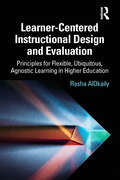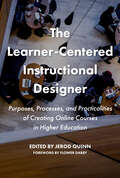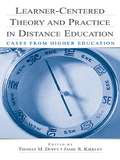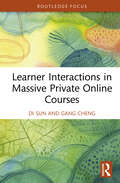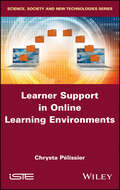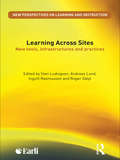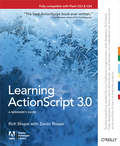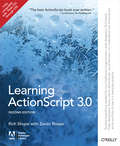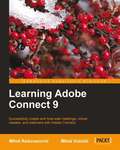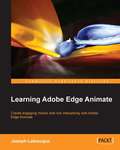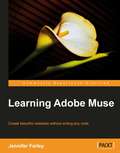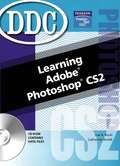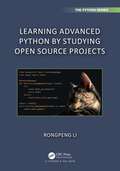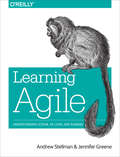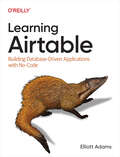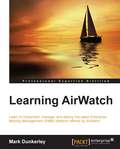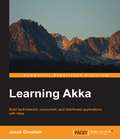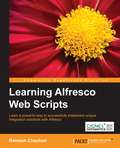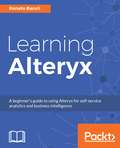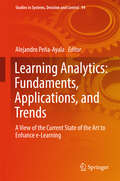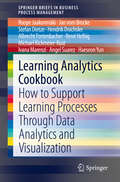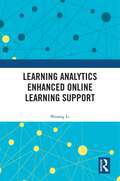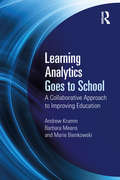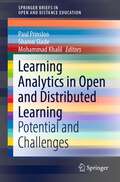- Table View
- List View
Learner-Centered Instructional Design and Evaluation: Principles for Flexible, Ubiquitous, Agnostic Learning in Higher Education
by Rasha AlOkailyLearner-Centered Instructional Design and Evaluation offers a forward-thinking, evidence-based vision of technology-enhanced higher education that taps into today’s digital access opportunities for more dynamic, agnostic, and inclusive learning experiences. The recent ubiquity of digital devices has fostered a new generation of learners who are technologically adept, engage in rapid social co-construction of knowledge, and expect increased choice and personalisation of educational content and environment. Colleges and universities, however, continue to apply their technology tools into outdated, passive pedagogies. Based on theory and empirical research, this book’s innovative framework guides scholars and practitioners toward instructional design and evaluation approaches that leverage the anytime-anywhere potential of wireless networked devices to foster flexible learning experiences and device-neutral assignments. Each chapter is rich with designs, deliveries, and evaluations of lesson plans, projects, and other real-world course works exemplifying the procedures and principles that will rejuvenate learning amid the globalisation, commodification, and massification of higher education.
The Learner-Centered Instructional Designer: Purposes, Processes, and Practicalities of Creating Online Courses in Higher Education
by Jerod Quinn Flower Darby“What does a new instructional designer need to know to find her or his feet when working with faculty to create online classes?” This is a practical handbook for established and aspiring instructional designers in higher education, readers who may also be identified by such professional titles as educational developer, instructional technologist, or online learning specialist. Jerod Quinn, together with a team of experienced instructional designers who have worked extensively with a wide range of faculty on a multiplicity of online courses across all types of institutions, offer key guiding principles, insights and advice on how to develop productive and collegial partnerships with faculty to deliver courses that engage students and promote enduring learning.Designing and developing online classes for higher education takes a combination of pedagogical knowledge, the ability to build trust with faculty, familiarity with frameworks on how people learn, understanding of accessibility and inclusion, and technical skills to leverage a learning management system into an educational experience. Coming from diverse backgrounds, few instructional designers enter academia well versed in all of these aspects of creating online classes. This book provides the foundation on which instructional designers can build their careers. The guiding principle that animates this book is that the student experience and successful learning outcomes are paramount, and governs discussion of course design, pedagogy, the use of multimedia and technological advances, as well as the use of different forms of interactive exercises and group assignments. The succinct, informally written chapters offer ideas and means to apply theory to the daily work of instructional design and cover the four key components that drive this work in higher education: ·Defining the scope and main design approaches of our work·Building trust with the faculty we work with·Applying frameworks of how people learn·Mastering common online instructional practices.
Learner-Centered Theory and Practice in Distance Education: Cases From Higher Education
by Thomas M. Duffy Jamie R. KirkleyLearner-Centered Theory and Practice in Distance Education: Cases From Higher Education brings the voice of the learning sciences to the study and design of distance learning. The contributors examine critical issues in the design of theoretically and pedagogically based distance education programs. Eight distance education programs are described in enough detail to allow readers with different interests to understand the pedagogical approaches and the implications of implementing those approaches. Issues of theory, pedagogy, design, assessment, communities of practice, collaboration, and faculty development are discussed.Each section of the book includes: *a primary chapter written by an author or authors involved with a distance education program that reflects learner-centered principles;*a formal reaction to the chapter by a specialist from the learning sciences, educational evaluation and policy, administration, or the corporate sector with expertise in issues of distance learning; and *an edited transcript of the authors' discussion of the primary chapter held at a symposium at the Asilomar Conference Center. A final "summing up" section offers two perspectives--from leading scholars outside the fields of instructional design, evaluation, and the learning sciences--on the approaches and thinking reflected in the rest of the book. This book is essential for researchers, as well as all those engaged in delivering, supporting, or administrating distance education programs at the post-secondary level. The descriptions, strategies, and principles will inform the design of continuing education, as well as degree-based education and corporate education and training, and distance education programs for adults.
Learner Interactions in Massive Private Online Courses
by Di Sun Gang ChengBy employing learning analytics methodology and big data in Learning Management Systems (LMSs), this volume conducts data-driven research to identify and compare learner interaction patterns in Massive Private Online Courses (MPOCs). The uncertainties about the temporal and sequential patterns of online interaction, and the lack of specific knowledge and methods to investigate details of LMSs' dynamic interaction traces have affected the improvement of online learning effectiveness. While most research focuses on Massive Open Online Courses (MOOCs), little is investigating the learners’ interaction behaviors in MPOCs. This book attempts to fill in the gaps by including research in the past decades, big data in education presenting micro-level interaction traces, analytics-based learner interaction in massive private open courses, and a case study. Aiming to bring greater efficiency and deeper engagement to individual learners, instructors, and administrators, the title provides a reference to those who need to evaluate their learning and teaching strategies in online learning. It will be particularly useful to students and researchers in the field of Education.
Learning Across Sites: New Tools, Infrastructures and Practices (New Perspectives on Learning and Instruction)
by Sten LudvigsenThe ever evolving, technology-intensive nature of the twenty-first century workplace has caused an acceleration in the division of labour, whereby work practices are becoming highly specialised and learning and the communication of knowledge is in a constant state of flux. This poses a challenge for education and learning: as knowledge and expertise increasingly evolve, how can individuals be prepared through education to participate in specific industries and organisations, both as newcomers and throughout their careers? Learning Across Sites brings together a diverse range of contributions from leading international researchers to examine the impacts and roles which evolving digital technologies have on our navigation of education and professional work environments. Viewing learning as a socially organised activity, the contributors explore the evolution of learning technologies and knowledge acquisition in networked societies through empirical research in a range of industries and workplaces. The areas of study include public administration, engineering, production, and healthcare and the contributions address the following questions: How are learning activities organised? How are tools and infrastructures used? What competences are needed to participate in specialised activities? What counts as knowledge in multiple and diverse settings? Where can parallels be drawn between workplaces? Addressing an emerging problem of adaptation in contemporary education, this book is essential reading for all those undertaking postgraduate study and research in the fields of educational psychology, informatics and applied information technology.
Learning ActionScript 3.0: The Non-Programmer's Guide to ActionScript 3.0
by Rich Shupe Zevan RosserIn this book, authors Rich Shupe and Zevan Rosser share the knowledge they've gained from their years as multimedia developers/designers and teachers. Learning ActionScript 3.0 gives you a solid foundation in the language of Flash and demonstrates how you can use it for practical, everyday projects.The authors do more than just give you a collection of sample scripts. Written for those of you new to ActionScript 3.0, the book describes how ActionScript and Flash work, giving you a clear look into essential topics such as logic, event handling, displaying content, migrating legacy projects to ActionScript 3.0, classes, and much more. You will learn important techniques through hands-on exercises, and then build on those skills as chapters progress.ActionScript 3.0 represents a significant change for many Flash users, and a steeper learning curve for the uninitiated. This book will help guide you through a variety of scripting scenarios. Rather than relying heavily on prior knowledge of object-oriented programming (OOP), topics are explained in focused examples that originate in the timeline, with optional companion classes for those already comfortable with their use. As chapters progress, the book introduces more and more OOP techniques, allowing you to choose which scripting approach you prefer.Learning ActionScript 3.0 reveals:New ways to harness the power and performance of AS3Common mistakes that people make with the languageEssential coverage of text, sound, video, XML, drawing with code, and moreMigration issues from AS1 and AS2 to AS3Simultaneous development of procedural and object-oriented techniquesTips that go beyond simple script collections, including how to approach a project and which resources can help you along the wayThe companion web site contains material for all the exercises in the book, as well as short quizzes to make sure you're up to speed with key concepts. ActionScript 3.0 is a different animal from previous versions, and Learning ActionScript 3.0 teaches everything that web designers, GUI-based Flash developers, and those new to ActionScript need to start using the language.
Learning ActionScript 3.0: A Beginner's Guide (Learning Ser.)
by Rich Shupe Zevan RosserIf you're new to ActionScript 3.0, or want to enhance your skill set, this bestselling book is the ideal guide. Designers, developers, and programmers alike will find Learning ActionScript 3.0 invaluable for navigating ActionScript 3.0's learning curve. You'll learn the language by getting a clear look at essential topics such as logic, event handling, displaying content, classes, and much more. Updated for Flash Professional CS5, this revised and expanded edition delivers hands-on exercises and full-color code samples to help you increase your abilities as you progress through the book. Topics are introduced with basic syntax and class-based examples, so you can set your own pace for learning object-oriented programming. Harness the power and performance of ActionScript 3.0 Control sound and video, including new access to microphone data Create art with code by drawing vectors and pixels at runtime Manipulate text with unprecedented typographic control Animate graphics, create particle systems, and apply simple physics Avoid common coding mistakes and reuse code for improved productivity Load SWF, image, text, HTML, CSS, and XML file formats, and more Authors Rich Shupe and Zevan Rosser draw on their experience as Flash developers and instructors to give you a solid ActionScript foundation, revealing ways you can use code for practical, everyday projects.
Learning ActionScript 3.0
by Richard Shupe Zevan RosserIf you're new to ActionScript 3.0, this is the ideal introductory guide. Flash designers, developers, and programmers alike will find this book invaluable for navigating ActionScript 3.0's steeper learning curve. You'll learn the language and how it works through hands-on exercises that build skills as the book progresses. You will learn how to: * Harness the power and performance of ActionScript 3.0 * Manipulate text, work with sound and video, and draw with code * Animate graphics, create particle systems, and apply simple physics * Avoid common coding mistakes and reuse code for improved productivity * Load SWF, image, text, HTML, CSS, and XML file formats, and more This second edition enhances the text further with improvements to clarity and understanding, tighter code examples, and new material. The skills taught, and majority of code examples, are fully compatible with Flash Professional versions CS3 through the present. Select new features introduced in versions CS4 or CS5 round out the content, including: * Manipulating assets using the basic 3D engine in Flash Player 10 * Significantly improved text control using the new Text Layout Framework * Expanded access to the user's microphone at runtime, and more This acclaimed four-color book features illustrations and screenshots throughout, but also presents all code examples in color. Syntax-colored scripts help you quickly identify key elements of the language and make it easier to compare the printed code to your own. The companion website is an additional resource for source files, short quizzes to test your knowledge of key concepts, and valuable supplemental material. Learning ActionScript 3.0 explains topics using simple examples written in the timeline, but also introduces object-oriented programming over time so you can get the most out of your reading. Or, if you prefer, the companion website includes class-based examples for every chapter, allowing you to choose if and when you immerse yourself in OOP. Written by teachers for students, authors Rich Shupe and Zevan Rosser draw on their vast experience as Flash developers and instructors to give you a solid ActionScript foundation, without losing site of creativity.
Learning Adobe Connect 9
by Milos Vucetic Milos RadovanovicWritten in an engaging, easy-to-follow style, Learning Adobe Connect 9 is a practical guide that will help you master the use of this web conferencing platform and its most important features.This book is ideal for users who would like to start utilizing Adobe Connect for web meetings, e-learning, and webinars. Those who are looking to learn Connect and get up to speed with using all of its features would find this book extremely useful.
Learning Adobe Edge Animate
by Joseph LabrecqueLearning Adobe Edge Animate is a practical, step-by-step tutorial on creating engaging content for the Web with Adobe's newest HTML5 tool. By taking a chapter-by-chapter look at each major aspect of Adobe Edge, the book lets you digest the available features in small, easily understandable chunks, allowing you to start using Adobe Edge for your web design needs immediately. If you are interested in creating engaging motion and interactive compositions using web standards with professional tooling, then this book is for you. Those with a background in Flash Professional wanting to get started quickly with Adobe Edge will also find this book useful.
Learning Adobe Muse
by Jennifer FarleyThis is an easy to read, practical, step by step guide covering the typical workflow for designing and building a website using Adobe Muse. As you work though the examples in the book you will build a fully-functioning website. The book includes many screenshots and graphics showing you exactly how to use the various features in Adobe Muse,This book is written for beginner web designers and also graphic designers who are interested in using their print design skills on the Web. It will teach you how to quickly build websites without the need to learn HTML or CSS.
Learning Adobe Photoshop Cs2
by Lisa A. BuckiDesigned for students at a variety of skill levels, Learning Adobe Photoshop CS2 teaches using real-world design examples. The Learning series provides students with a total-immersion, hands-on tutorial that walks them step-by-step, mouse-click by mouse-click, keystroke by keystroke through all the features of the software application. The well-illustrated, spiral-bound text contains easy-to-read, appealingly formatted procedural explanations and step-by-step exercises in a multi-part Lesson format.
Learning Advanced Python by Studying Open Source Projects (Chapman & Hall/CRC The Python Series)
by Rongpeng LiThis book is one of its own kind. It is not an encyclopedia or a hands-on tutorial that traps readers in the tutorial hell. It is a distillation of just one common Python user’s learning experience. The experience is packaged with exceptional teaching techniques, careful dependence unraveling and, most importantly, passion. Learning Advanced Python by Studying Open Source Projects helps readers overcome the difficulty in their day-to-day tasks and seek insights from solutions in famous open source projects. Different from a technical manual, this book mixes the technical knowledge, real-world applications and more theoretical content, providing readers with a practical and engaging approach to learning Python. Throughout this book, readers will learn how to write Python code that is efficient, readable and maintainable, covering key topics such as data structures, algorithms, object-oriented programming and more. The author’s passion for Python shines through in this book, making it an enjoyable and inspiring read for both beginners and experienced programmers.
Learning Agile: Understanding Scrum, XP, Lean, and Kanban
by Jennifer Greene Andrew StellmanAgile has revolutionized the way teams approach software development, but with dozens of agile methodologies to choose from, the decision to "go agile" can be tricky. This practical book helps you sort it out, first by grounding you in agile's underlying principles, then by describing four specific--and well-used--agile methods: Scrum, extreme programming (XP), Lean, and Kanban.Each method focuses on a different area of development, but they all aim to change your team's mindset--from individuals who simply follow a plan to a cohesive group that makes decisions together. Whether you're considering agile for the first time, or trying it again, you'll learn how to choose a method that best fits your team and your company.Understand the purpose behind agile's core values and principlesLearn Scrum's emphasis on project management, self-organization, and collective commitmentFocus on software design and architecture with XP practices such as test-first and pair programmingUse Lean thinking to empower your team, eliminate waste, and deliver software fastLearn how Kanban's practices help you deliver great software by managing flowAdopt agile practices and principles with an agile coach
Learning Airtable: Building Database-driven Applications With No-code
by Elliott AdamsGet a concise yet comprehensive overview of Airtable, one of the most versatile platforms to emerge from the no-code movement. Whether you're planning a new project, sharing data analysis within your organization, tracking a detailed initiative among stakeholders, or dealing with any other project that requires well-structured collaboration, this practical book shows you how Airtable is an accessible tool to tackle these challenges.Author Elliott Adams guides you through the process of structuring your data in a relational database, creating automations based on changes to data in Airtable, and building user-friendly interfaces for no-code applications. This showcases how Airtable is superior to the typical options of either non-developers using spreadsheets or making large investments in time-consuming application development.With this book, you will:Learn how Airtable can reduce the need for custom-built applicationsUse Airtable to replace internal tools such as spreadsheetsBuild applications utilizing relational data--without any knowledge of software programmingEvaluate whether you can build a solution on Airtable rather than purchasing softwareUnderstand the limitations of the Airtable platform when compared with writing a software application from scratch
Learning AirWatch
by Mark DunkerleyIf you are a technical professional who wants to dive deeper into the functionality offered by AirWatch or manage the solution, then this book will help you choose the best set of configuration, device management, and monitoring options that you can use to effectively manage your EMM implementation.
Learning Akka
by Jason GoodwinBuild fault tolerant concurrent and distributed applications with Akka About This Book * Build networked applications that self-heal * Scale out your applications to handle more traffic faster * An easy-to-follow guide with a number of examples to ensure you get the best start with Akka Who This Book Is For This book is intended for beginner to intermediate Java or Scala developers who want to build applications to serve the high-scale user demands in computing today. If you need your applications to handle the ever-growing user bases and datasets with high performance demands, then this book is for you. Learning Akka will let you do more for your users with less code and less complexity, by building and scaling your networked applications with ease. What You Will Learn * Use Akka to overcome the challenges of concurrent programming * Resolve the issues faced in distributed computing with the help of Akka * Scale applications to serve a high number of concurrent users * Make your system fault-tolerant with self-healing applications * Provide a timely response to users with easy concurrency * Reduce hardware costs by building more efficient multi-user applications * Maximise network efficiency by scaling it In Detail Software today has to work with more data, more users, more cores, and more servers than ever. Akka is a distributed computing toolkit that enables developers to build correct concurrent and distributed applications using Java and Scala with ease, applications that scale across servers and respond to failure by self-healing. As well as simplifying development, Akka enables multiple concurrency development patterns with particular support and architecture derived from Erlang's concept of actors (lightweight concurrent entities). Akka is written in Scala, which has become the programming language of choice for development on the Akka platform. Learning Akka aims to be a comprehensive walkthrough of Akka. This book will take you on a journey through all the concepts of Akka that you need in order to get started with concurrent and distributed applications and even build your own. Beginning with the concept of Actors, the book will take you through concurrency in Akka. Moving on to networked applications, this book will explain the common pitfalls in these difficult problem areas while teaching you how to use Akka to overcome these problems with ease. The book is an easy to follow example-based guide that will strengthen your basic knowledge of Akka and aid you in applying the same to real-world scenarios. Style and approach An easy-to-follow, example-based guide that will take you through building several networked-applications that work together while you are learning concurrent and distributed computing concepts. Each topic is explained while showing you how to design with Akka and how it is used to overcome common problems in applications. By showing Akka in context to the problems, it will help you understand what the common problems are in distributed applications and how to overcome them.
Learning Alfresco Web Scripts
by Ramesh ChauhanIf you are an Alfresco developer who has no experience with web scripts and you want to start developing Alfresco web scripts, then this book is definitely for you.
Learning Alteryx: A beginner's guide to using Alteryx for self-service analytics and business intelligence
by Alok Khobragade Mayur Ravindra Narkhede Renato BarutiKey Features Experience the power of codeless analytics using Alteryx, a leading Business Intelligence tool Uncover hidden trends and valuable insights from your data across different sources and make accurate predictions Includes real-world examples to put your understanding of the features in Alteryx to practical use Book Description Alteryx, as a leading data blending and advanced data analytics platform, has taken self-service data analytics to the next level. Companies worldwide often find themselves struggling to prepare and blend massive datasets that are time-consuming for analysts. Alteryx solves these problems with a repeatable workflow designed to quickly clean, prepare, blend, and join your data in a seamless manner. This book will set you on a self-service data analytics journey that will help you create efficient workflows using Alteryx, without any coding involved. It will empower you and your organization to take well-informed decisions with the help of deeper business insights from the data.Starting with the fundamentals of using Alteryx such as data preparation and blending, you will delve into the more advanced concepts such as performing predictive analytics. You will also learn how to use Alteryx’s features to share the insights gained with the relevant decision makers. To ensure consistency, we will be using data from the Healthcare domain throughout this book. The knowledge you gain from this book will guide you to solve real-life problems related to Business Intelligence confidently. Whether you are a novice with Alteryx or an experienced data analyst keen to explore Alteryx’s self-service analytics features, this book will be the perfect companion for you. What you will learn Create efficient workflows with Alteryx to answer complex business questions Learn how to speed up the cleansing, data preparing, and shaping process Blend and join data into a single dataset for self-service analysis Write advanced expressions in Alteryx leading to an optimal workflow for efficient processing of huge data Develop high-quality, data-driven reports to improve consistency in reporting and analysis Explore the flexibility of macros by automating analytic processes Apply predictive analytics from spatial, demographic, and behavioral analysis and quickly publish, schedule Share your workflows and insights with relevant stakeholders
Learning Analytics: Fundaments, Applications, and Trends
by Alejandro Peña-AyalaThis book provides a conceptual and empirical perspective on learning analytics, its goal being to disseminate the core concepts, research, and outcomes of this emergent field. Divided into nine chapters, it offers reviews oriented on selected topics, recent advances, and innovative applications. It presents the broad learning analytics landscape and in-depth studies on higher education, adaptive assessment, teaching and learning. In addition, it discusses valuable approaches to coping with personalization and huge data, as well as conceptual topics and specialized applications that have shaped the current state of the art. By identifying fundamentals, highlighting applications, and pointing out current trends, the book offers an essential overview of learning analytics to enhance learning achievement in diverse educational settings. As such, it represents a valuable resource for researchers, practitioners, and students interested in updating their knowledge and finding inspirations for their future work.
Learning Analytics Cookbook: How to Support Learning Processes Through Data Analytics and Visualization (SpringerBriefs in Business Process Management)
by Roope Jaakonmäki Stefan Dietze Hendrik Drachsler Albrecht Fortenbacher René Helbig Michael Kickmeier-Rust Ivana Marenzi Angel Suarez Haeseon Yun Jan vom BrockeThis book offers an introduction and hands-on examples that demonstrate how Learning Analytics (LA) can be used to enhance digital learning, teaching and training at various levels. While the majority of existing literature on the subject focuses on its application at large corporations, this book develops and showcases approaches that bring LA closer to smaller organizations, and to educational institutions that lack sufficient resources to implement a full-fledged LA infrastructure. In closing, the book introduces a set of software tools for data analytics and visualization, and explains how they can be employed in several LA scenarios.
Learning Analytics Enhanced Online Learning Support
by Shuang LiOffering the latest developments in online education in the era of big data, this book explores theories, technologies, and practices in the field of data-driven online learning support services using learning analytics. This book is divided into five chapters. Chapter 1 reflects and reconstructs the connotation of learning support against the backdrop of education reform, the rise of learning analytics, and the upgrading of the demand for learning services in the new era. Chapter 2 presents a P-K-DSE-E model of online learner characteristics and discusses measurement and data representation methods for learner characteristics based on it. Chapters 3–5 focus on the three types of learning support that are closely related to learning performance and satisfaction, including the promotion of social learning, electronic learning assessment based on the learning process, and personalized tutoring and support. This book innovatively develops the concept, theory, and practical methods of student support services in distance education traditional practices in the new era and provides valuable exploration of data-driven personalized learning service methods and technologies in the era of artificial intelligence through rich examples. This book will be essential reading for students and scholars of distance and online education, educational technology, and audiovisual education.
Learning Analytics Goes to School: A Collaborative Approach to Improving Education
by Andrew Krumm Barbara Means Marie BienkowskiLearning Analytics Goes to School presents a framework for engaging in education research and improving education practice through the use of newly available data sources and analytical approaches. The application of data-intensive research techniques to understanding and improving learning environments has been growing at a rapid pace. In this book, three leading researchers convey lessons from their own experiences—and the current state of the art in educational data mining and learning analytics more generally—by providing an explicit set of tools and processes for engaging in collaborative data-intensive improvement.
Learning Analytics in Open and Distributed Learning: Potential and Challenges (SpringerBriefs in Education)
by Paul Prinsloo Sharon Slade Mohammad KhalilThis book explores and further expands on the rich history of theoretical and empirical research in open and distributed learning, and addresses the impact of the “data revolution” and the emergence of learning analytics on this increasingly diverse form of educational delivery. Following an introductory chapter that maps the book’s conceptual rationale, the book discusses the potential, challenges and practices of learning analytics in various open and distributed contexts. A concluding chapter briefly summarises the chapters before providing a tentative future research agenda for learning analytics in open and distributed environments.
